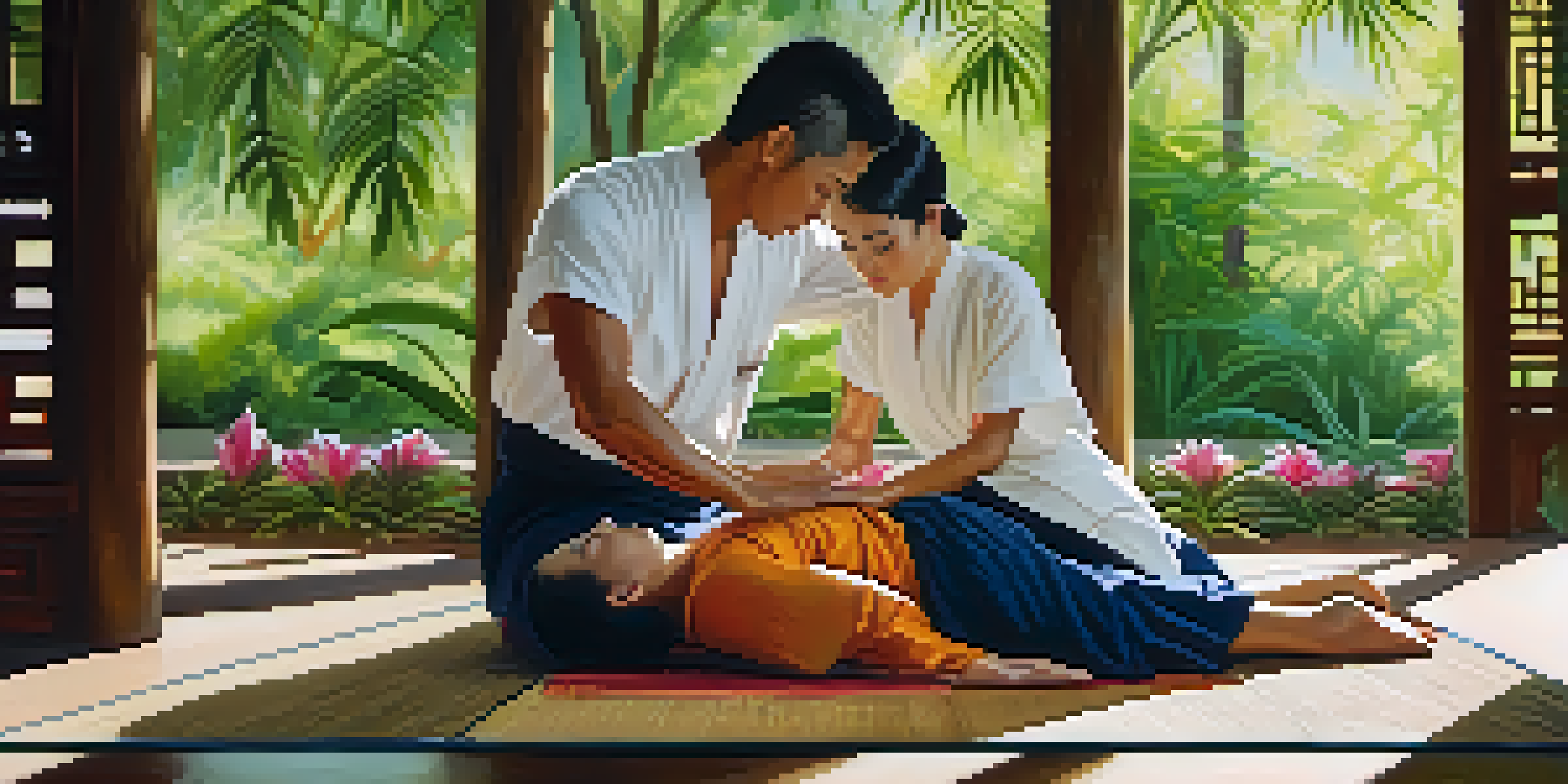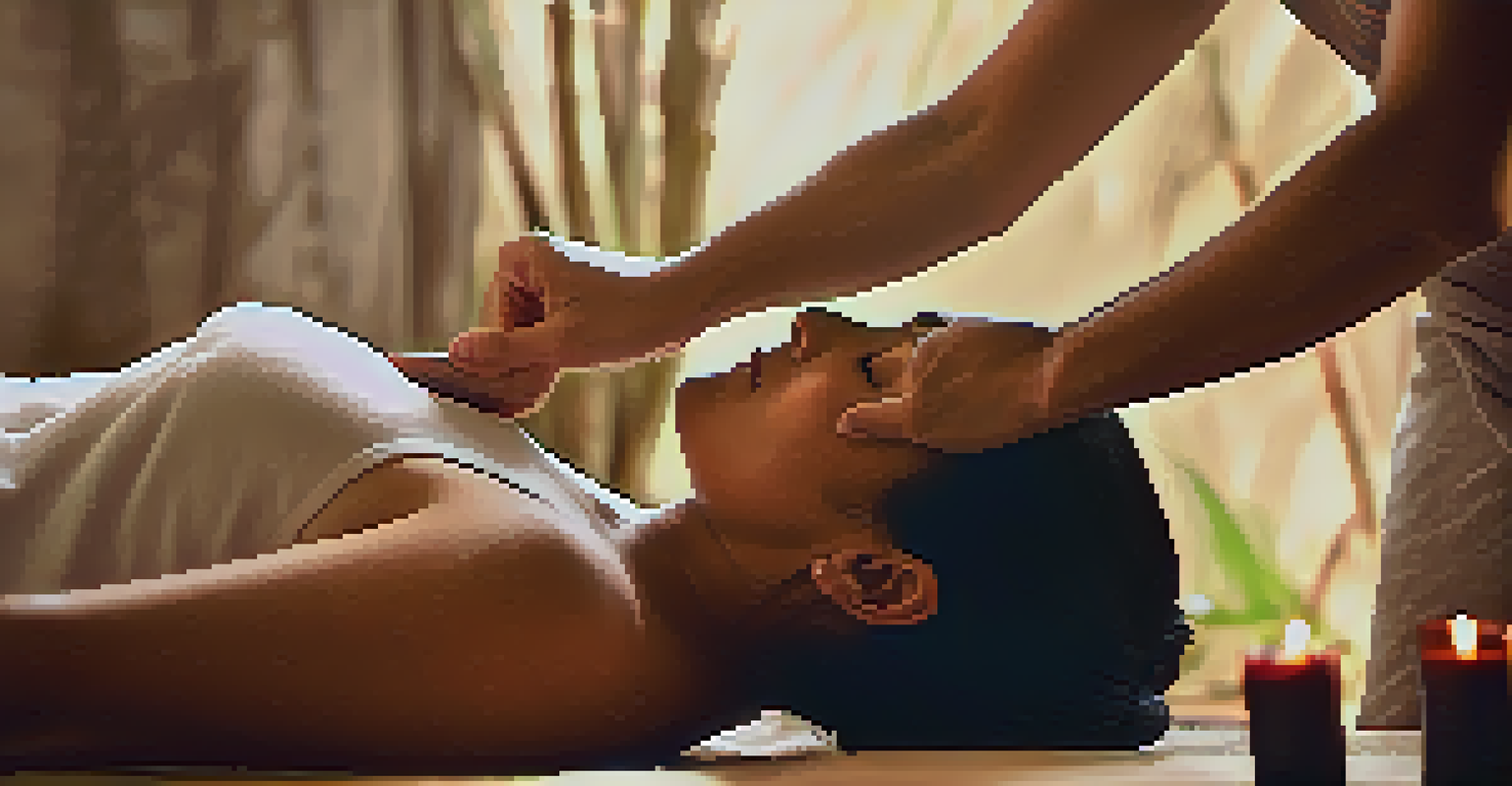Thai Massage vs. Other Massage Styles: A Comparative Study

Understanding Thai Massage: An Ancient Art Form
Thai massage, also known as Nuad Bo-Rarn, is rooted in ancient healing traditions and combines acupressure with yoga-like stretching. Originating over 2,500 years ago in Thailand, this massage style is often seen as a holistic approach to wellness. Rather than just focusing on muscle relaxation, Thai massage aims to promote energy flow and balance throughout the body.
Massage is not just a luxury. It's a way to a healthier, happier life.
Practitioners use their hands, elbows, knees, and feet to manipulate the body into various positions, which can feel invigorating yet deeply relaxing. This makes Thai massage distinct from traditional Western approaches, where the focus is usually more on muscle tension relief. It’s like a gentle workout that leaves you feeling both energized and serene.
Overall, Thai massage is not just about the physical benefits; it’s also about connecting the mind, body, and spirit. This unique approach sets it apart and makes it appealing for those seeking more than just a typical massage experience.
Comparing Techniques: Thai Massage vs. Swedish Massage
Swedish massage is among the most popular forms of massage in the Western world, known for its gentle strokes and focus on relaxation. In contrast, Thai massage is much more dynamic and involves assisted stretching and acupressure techniques. While Swedish massage uses oils and is performed on a massage table, Thai massage is typically done on a mat on the floor, allowing for greater movement and flexibility.

An important distinction is the pressure applied during each style. Swedish massage often uses lighter pressure to promote relaxation, whereas Thai massage can incorporate deeper pressure to release tension and enhance flexibility. This difference makes Swedish massage ideal for those looking for soothing relief, while Thai massage is better suited for those wanting an active, stretching experience.
Thai Massage: A Holistic Approach
Thai massage combines stretching and acupressure to promote energy flow and balance throughout the body.
In a nutshell, if you’re seeking relaxation, Swedish massage might be your go-to. But if you’re looking for a more invigorating and holistic approach, Thai massage could be the perfect fit.
The Role of Breath in Thai Massage
Breathing is a key component of Thai massage, deeply intertwined with its techniques. Clients are often encouraged to synchronize their breath with the movements of the therapist, helping to enhance relaxation and release tension. This mindful breathing practice not only enriches the massage experience but also promotes overall wellness.
In every movement, there is a story, and in every story, there is a movement.
Unlike many other massage styles, where breathing may not play as significant a role, Thai massage elevates it to an integral part of the process. For instance, as a therapist stretches your body, you may be guided to inhale deeply, allowing your muscles to relax and open. This makes the session not only a physical experience but also a meditative one.
Thus, the emphasis on breath in Thai massage can lead to a deeper sense of connection with your body, bringing a unique aspect to the overall experience.
Cultural Influences on Thai Massage
Thai massage is heavily influenced by Buddhist practices and traditional Thai medicine, making it a culturally rich therapy. The philosophy behind it often includes elements of energy work, where practitioners believe that blockages in energy flow can lead to physical discomfort. This understanding shapes how Thai massage is approached, focusing on restoring balance.
In contrast, many Western massage styles tend to focus more on the physical aspects of muscle tension and pain relief. For example, sports massage might concentrate on specific injuries or muscle groups, while Thai massage offers a broader view by considering the body as a whole. It’s like comparing a detailed map of a neighborhood to a satellite view of an entire city.
Breath Enhances Massage Experience
Mindful breathing during Thai massage deepens relaxation and connects the mind, body, and spirit.
This cultural depth in Thai massage not only enhances its therapeutic effects but also provides a unique journey of discovery for those who partake in it.
Benefits of Thai Massage: More Than Just Relaxation
One of the standout benefits of Thai massage is its ability to improve flexibility and range of motion. The assisted stretching techniques help to lengthen muscles and improve overall mobility, making it an excellent choice for athletes or anyone with a physically demanding lifestyle. It’s like giving your body a thorough tune-up, allowing it to move more freely.
In addition to improved flexibility, many people report feeling a heightened sense of energy and mental clarity after a session. This is largely due to the focus on energy lines and the practice of mindful breathing. Unlike some massage styles that may leave you feeling sleepy, Thai massage can rejuvenate and invigorate, paving the way for increased productivity.
Overall, the benefits of Thai massage extend beyond just relaxation, offering a holistic approach to physical and mental wellness.
Who Should Try Thai Massage? A Broad Audience
Thai massage is suitable for a wide range of individuals, from active athletes to those with sedentary lifestyles. Its focus on stretching and movement can be particularly beneficial for anyone looking to enhance their flexibility or recover from physical activity. It’s like a personal trainer’s session, but with the added relaxation of a massage.
However, it’s important to note that those with specific medical conditions or injuries should consult a healthcare professional before trying Thai massage. The deep pressure and stretching involved might not be appropriate for everyone. For instance, individuals with severe injuries or certain chronic conditions may need to explore gentler alternatives.
Wide Appeal for Various Lifestyles
Thai massage benefits a diverse audience, from athletes seeking flexibility to individuals looking for relaxation.
That said, if you’re generally healthy and seeking a unique, invigorating experience, Thai massage could be a fantastic addition to your wellness routine.
Final Thoughts: Choosing Your Massage Style Wisely
When it comes to choosing a massage style, it ultimately depends on your personal preferences and wellness goals. Thai massage offers a unique blend of stretching, acupressure, and mindfulness that appeals to those looking for a more holistic experience. On the other hand, if you prefer a more traditional approach focused solely on relaxation, styles like Swedish or deep tissue massage might be a better fit.
Consider what you hope to gain from your massage experience. Are you looking to relieve tension, improve flexibility, or simply unwind? Each style has its unique benefits, and understanding these differences can help you make the right choice.

In conclusion, whether you opt for the dynamic flow of Thai massage or another style, the most important thing is to listen to your body and choose what feels best for you.